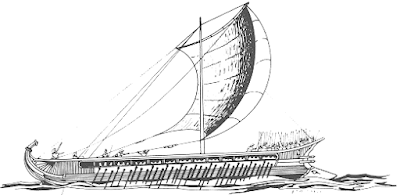Who would have thought that one of the letters that was the easiest for me to decide upon was the letter X? When I was preparing my list for this series of Blogging through the Alphabet, I knew the Persian king, Xerxes, would be a perfect choice. However, I did not realize that finding information about him would prove to be difficult if I wasn't relying up on the Internet.
Xerxes I ruled the Persian Empire from 486 BC, when he succeeded his father Darius I, to 465 BC, when he was assassinated. While he was king, he expanded the Persian Empire to include territory from modern-day Turkey and the North African coast all the way to the Indus River Valley. He also led a war against the Greek city-states. The land and sea force that Xerxes raised to attack the Greeks included more than 180,000 men.
There are perhaps two things for which Xerxes is most remembered – the continuation of building his father's city and the capture and burning of Athens in 480 BC.
Persepolis
The third capital of the Persian Empire – Persepolis – was started by Darius I. When Xerxes took over the empire, he continued to work on completing the city. It is believed that Xerxes finished the work on the Treasury and its surrounding buildings. The city would disappear from history when Alexander the Great covered the city by earth but it would be excavated in the 1940s. In Persepolis, we see the diversity of the empire represented in the variety of architectural styles. One can find a great palace complex that holds offices, treasuries, reception halls, and audience halls.
Attack on Greek City-States
Perhaps the Spartans that faced Xerxes' troops at the mountain pass of Thermopylae are remembered more than the Persian king is? At the Battle of Thermopylae, Spartans held back the Persian troops as they marched south from Macedonia until a traitor told Xerxes of another pass through the mountains.
The Persians were able to push towards Athens. They captured and burned the city – including the Acropolis. Even though the Persians were victorious over the Athenians on land, things would not work out in their favor at sea.
Approximately 1000 Persian ships sailed from home and they met the Greeks in the Bay of Salamis. The Greeks had a fleet of 20 triremes which were better suited to maneuvering in the bay. The Greeks were able to crush the Persian fleet while Xerxes watched from shore. With the defeat, he returned to Asia Minor. The Persians would never attack the Greek city-states again.
I created a Emperors of Persia Handout for you to download this week! It lists the emperors from Cyrus the Great to Darius III.






Interesting reading.
ReplyDeleteThank you!
DeleteThis is great!
ReplyDeleteI love how you choose interesting things for your alphabet. Such a great idea and super informative.
ReplyDeleteHow informative! Thank you for the extra tidbits on Xerxes, along with the Persian Emperor printable. These will come in handy!
ReplyDeleteAncient history like this is so intriguing! Thanks for providing this resource!
ReplyDeleteVery interesting and informative!
ReplyDeleteWhat a fun idea, I've never thought of blogging through the alphabet!
ReplyDeleteI love how you are going through the alphabet like this!
ReplyDeleteFantastic choice for X! I knew who he was, but you taught me some fun new facts today.
ReplyDeleteA wonderful Way to go through the alphabet. Neat tidbits of info.
ReplyDelete